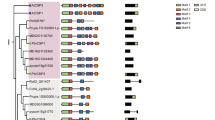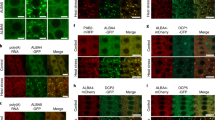Abstract
Plant meiotic prophase I is a complicated process involving the late zygotene and pachytene stages, both crucial for completing synapsis and recombination. Using David Lily (Lilium davidii var. Willmottiae) as our research material, we performed suppression subtractive hybridization to construct EST library of anthers at various stages of development by the pollen mother cells. From this library, we identified small heat shock protein LimHSP16.45 was highly expressed during the late zygotene to pachytene stages. Our results also showed that LimHSP16.45 was almost specifically expressed in the anther compared with the root, stem, or leaf, and in situ expression of LimHSP16.45 mRNAs showed strong signals in the pollen mother cells and tapetal cells. LimHSP16.45 could be induced by heat and cold in lily anthers, and its ectopic expression enhanced the viability of E. coli cells under both high and low temperatures. In vitro, it acted as molecular chaperone and could help luciferase refolding after heat shock stress. All of these data suggest that LimHSP16.45, working as molecular chaperone, possibly protects pollen mother cells and tapetal cells against extreme temperatures during late zygotene to pachytene stages of meiotic prophase I in David Lily.






Similar content being viewed by others
References
Atkinson BG, Raizada M, Bouchard RA, Frappier JRH, Walden DB (1993) The independent stage-specific expression of the 18 kDa heat shock protein genes during microsporogenesis in Zea mays L. Dev Genet 14:15–26
Boston RS, Viitanen PV, Vierling E (1996) Molecular chaperones and protein folding in plants. Plant Mol Biol 32:191–222
Cabane M, Calvet P, Vincens P, Boudet AM (1993) Characterization of chilling-acclimation-related proteins in soybean and identification of one as a member of the heat shock protein (HSP70) family. Planta 190:346–353
Coen ES, Romero JM, Doyle S, Elliot R, Murphy G, Carpenter R (1990) Floricaula a homeotic gene required for flower development in Antirrhinum majus. Cell 63:1311–1322
Dietrich PS, Bouchard RA, Casey ES, Sinibaldi RM (1991) Isolation and characterization of a small heat shock protein gene from maize. Plant Physiol 96:1268–1276
Hamant O, Ma H, Cande WZ (2006) Genetics of meiotic prophase I in plants. Annu Rev Plant Biol 57:267–302
Hamilton EW, Heckathorn SA (2001) Mitochondrial adaptations to NaCl. Complex I is protected by anti-oxidants and small heat shock proteins, whereas complex II is protected by proline and betaine. Plant Physiol 126:1266–1274
Hopf N, Plesofsky-Vig N, Brambl R (1992) The heat shock response of pollen and other tissues of maize. Plant Mol Biol 19:623–630
Horwitz J (1992) a-Crystallin can function as a molecular chaperone. Proc Natl Acad Sci USA 89:10449–10453
Huijser P, Klien J, Lonnig WE, Meijer H, Saedler H, Sommer H (1992) Bracteomania, an inflorescence anomaly is caused by the loss of function of the MADS-box gene SQUAMOSA in Antirrhinum majus. EMBO J 11:1239–1249
Jakob U, Gaestel M, Engel K, Buchner J (1993) Small heat shock proteins are molecular chaperones. J Biol Chem 268:1517–1520
Keeler SJ, Boettger CM, Haynes JG, Kuches KA, Johnson MM, Thureen DL, Keeler CL, Kitto SL (2000) Acquired thermotolerance and expression of the HSP100/ClpB genes of Lima Bean. Plant Physiol 123:1121–1132
Krishna P, Sacco M, Cherutti JF, Hill S (1995) Cold-induced accumulation of hsp90 transcripts in Brassica napus. Plant Physiol 107:915–923
Kobayashi T, Kobayashi E, Sato S, Hotta Y, Miyajima N, Tanaka A, Tabata S (1994) Characterization of cDNAs induced in meiotic prophase in lily microsporocytes. DNA Res 1:15–26
Krogh BO, Symington LS (2004) Recombination proteins in yeast. Annu Rev Genet 38:233–271
Lam WS, Yang X, Makaroff CA (2005) Characterization of Arabidopsis thaliana SMC1 and SMC3: evidence that AtSMC3 may function beyond chromosome cohesion. J Cell Sci 118:3037–3048
Lee BH, Won SH, Lee HS, Miyao M, Chung WI, Kim IJ, Jo J (2000) Expression of the chloroplast-localized small heat shock protein by oxidative stress in rice. Gene 245:283–290
Lee GJ, Roseman AM, Saibil HR, Vierling E (1997) A small heat shock protein stably binds heat-denatured model substrates and can maintain a substrate in a folding-competent state. EMBO J 16(3):659–671
Livak KJ, Schmittgen TD (2001) Analysis of relative gene expression data using real-time quantitative PCR and the 2DDCT method. Methods 25(4):402–408
Low D, Brandle K, Nover L, Forreiter C (2000) Cytosolic heat-stress proteins Hsp17.7 class I and Hsp17.3 class II of tomato act as molecular chaperones in vivo. Planta 211:575–582
Malik MK, Slovin JP, Hwang CH, Zimmerman JL (1999) Modified expression of a carrot small heat shock protein gene, hsp17.7, results in increased or decreased thermotolerance double danger. Plant J 20:89–99
Masson JY, West SC (2001) The Rad51 and Dmc1 recombinases: a non-identical twin relationship. Trends Biochem Sci 26:131–136
Merck KB, Groenen PJ, Voorter CE, de Haard-Hoekman WA, Horwitz J, Bloemendal H, de Jong WW (1993) Structural and functional similarities of bovine-crystallin and mouse small heat-shock protein. J Biol Chem 268:1046–1052
Nakai A (1999) New aspects in the vertebrate heat stress factor system: HsfA3 and HsfA4. Cell Stress Chaperones 4:86–93
Nover L (1991) Heat shock response. CRC Press, Boca Raton
Nover L, Scharf KD (1997) Heat stress proteins and transcription factors. Cell MOI Life Sci 53:80–103
Nover L, Bharti K, Doring P, Mishra SK, Ganguli A, Schart KD (2001) Arabidopsis and the heat stress transcription factor world: how many heat stress transcription factors do we need? Cell Stress Chaperones 6(3):177–189
Osman K, Higgins JD, Sanchez-Moran E, Armstrong SJ, Franklin FCH (2011) Pathways to meiotic recombination in Arabidopsis thaliana. New Phytol 190(3):523–544
Parsell DA, Lindquist S (1993) The function of heat-shock proteins in stress tolerance: degradation and reactivation of proteins. Annu Rev Genet 27:437–496
Prandl R, Kloske E, SchOffl F (1995) Developmental regulation and tissue-specific differences of heat shock gene expression in transgenic tobacco and Arabidopsis plants. Plant Mol Biol 28:73–82
Puizina J, Siroky J, Mokros P, Schweizer D, Riha K (2004) Mre11 deficiency in Arabidopsis is associated with chromosomal instability in somatic cells and Spo11-dependent genome fragmentation during meiosis. Plant Cell 16:1968–1978
Ross-Macdonald P, Roeder GS (1994) Mutation of a meiosis-specific MutS homolog decreases crossing over but not mismatch correction. Cell 79:1069–1080
Sambrook J, Fritsch EF, Maniatis T (1989) Molecular cloning, a laboratory manual, 2nd edn. Cold Spring Harbor Laboratory Press, New York
Sato Y, Yokoya S (2008) Enhanced tolerance to drought stress in transgenic rice plants overexpressing a small heat-shock protein smHSPs17.7. Plant Cell Rep 27:329–334
Siaud N, Dray E, Gy I, Gerard E, Takvorian N, Doutriaux MP (2004) Brca2 is involved in meiosis in Arabidopsis thaliana as suggested by its interaction with Dmc1. EMBO J 23:1392–1401
Sun W, Bernard C, van de Cotte B, van Montagu M, Verbruggen N (2001) At-HSP17.6A, encoding a small heat-shock protein in Arabidopsis, can enhance osmotolerance upon overexpression. Plant J 27:407–415
Vierling E (1991) The roles of heat shock proteins in plants. Plant Mol Biol 42:579–620
Volkov RA, Panchuk II, Schoffl F (2005) Small heat shock proteins are differentially regulated during pollen development and following heat stress in tobacco. Plant Mol Biol 57(4):487–502
Wang W, Vinocur B, Shoseyov O, Altman A (2004) Role of plant heat-shock proteins and molecular chaperones in the abiotic stress response. Trends Plant Sci 9:244–252
Waters ER, Lee GJ, Vierling E (1996) Evolution, structure and function of the small heat shock proteins in plants. J Exp Bot 47:325–338
Wei LQ, Wen YX, Zhu YD, Su Z, Xue YB, Wang T (2010) Genome-scale analysis and comparison of gene expression profiles in developing and germinated pollen in Oryza sativa. BMC Genomics 11:338
Yang JF, Stewart GR (1991) Response of higher plants to heat shock. Acta Botanica Sinica 33:292–296
Yoon HJ, Kim KP, Park SM, Hong CB (2005) Functional Mode of NtHSP1 7.6, a cytosolic small heat-shock protein from Nicotiana tabacum. J Plant Biol 48(1):120–127
Yoo SD, Cho YH, Sheen J (2007) Arabidopsis mesophyll protoplasts: a versatile cell system for transient gene expression analysis. Nat Protoc 2:1565–1572
Zou J, Liu AL, Chen XB, Zhou XY, Gao GF, Wang WF, Zhang XW (2009) Expression analysis of nine rice heat shock protein genes under abiotic stresses and ABA treatment. J Plant Physiol 166(8):851–861
Acknowledgments
This work was financially supported by grants from the National Natural Science Foundation of China (No. 30970234), the Chunhui Program of Chinese Ministry of Education (2009), and Fundamental Research Funds for the Central Universities (No. lzujbky-2010-58).
Author information
Authors and Affiliations
Corresponding author
Additional information
Communicated by F. Brandizzi.
Rights and permissions
About this article
Cite this article
Mu, C., Wang, S., Zhang, S. et al. Small heat shock protein LimHSP16.45 protects pollen mother cells and tapetal cells against extreme temperatures during late zygotene to pachytene stages of meiotic prophase I in David Lily . Plant Cell Rep 30, 1981–1989 (2011). https://doi.org/10.1007/s00299-011-1106-y
Received:
Revised:
Accepted:
Published:
Issue Date:
DOI: https://doi.org/10.1007/s00299-011-1106-y




